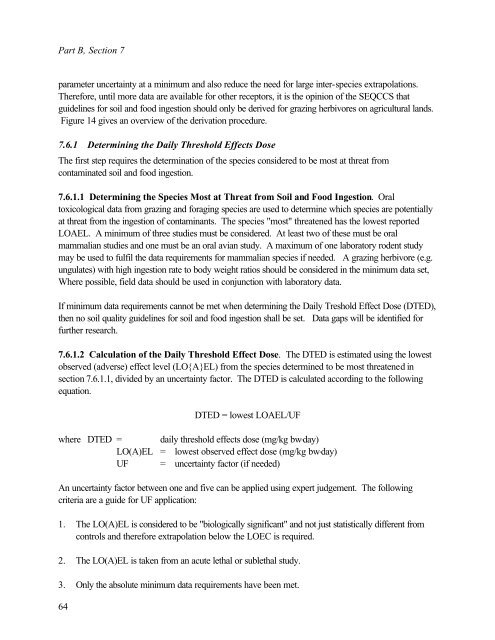Protocol for the Derivation of Environmental and Human ... - CCME
Protocol for the Derivation of Environmental and Human ... - CCME
Protocol for the Derivation of Environmental and Human ... - CCME
You also want an ePaper? Increase the reach of your titles
YUMPU automatically turns print PDFs into web optimized ePapers that Google loves.
Part B, Section 7<br />
parameter uncertainty at a minimum <strong>and</strong> also reduce <strong>the</strong> need <strong>for</strong> large inter-species extrapolations.<br />
There<strong>for</strong>e, until more data are available <strong>for</strong> o<strong>the</strong>r receptors, it is <strong>the</strong> opinion <strong>of</strong> <strong>the</strong> SEQCCS that<br />
guidelines <strong>for</strong> soil <strong>and</strong> food ingestion should only be derived <strong>for</strong> grazing herbivores on agricultural l<strong>and</strong>s.<br />
Figure 14 gives an overview <strong>of</strong> <strong>the</strong> derivation procedure.<br />
7.6.1 Determining <strong>the</strong> Daily Threshold Effects Dose<br />
The first step requires <strong>the</strong> determination <strong>of</strong> <strong>the</strong> species considered to be most at threat from<br />
contaminated soil <strong>and</strong> food ingestion.<br />
7.6.1.1 Determining <strong>the</strong> Species Most at Threat from Soil <strong>and</strong> Food Ingestion. Oral<br />
toxicological data from grazing <strong>and</strong> <strong>for</strong>aging species are used to determine which species are potentially<br />
at threat from <strong>the</strong> ingestion <strong>of</strong> contaminants. The species "most" threatened has <strong>the</strong> lowest reported<br />
LOAEL. A minimum <strong>of</strong> three studies must be considered. At least two <strong>of</strong> <strong>the</strong>se must be oral<br />
mammalian studies <strong>and</strong> one must be an oral avian study. A maximum <strong>of</strong> one laboratory rodent study<br />
may be used to fulfil <strong>the</strong> data requirements <strong>for</strong> mammalian species if needed. A grazing herbivore (e.g.<br />
ungulates) with high ingestion rate to body weight ratios should be considered in <strong>the</strong> minimum data set,<br />
Where possible, field data should be used in conjunction with laboratory data.<br />
If minimum data requirements cannot be met when determining <strong>the</strong> Daily Treshold Effect Dose (DTED),<br />
<strong>the</strong>n no soil quality guidelines <strong>for</strong> soil <strong>and</strong> food ingestion shall be set. Data gaps will be identified <strong>for</strong><br />
fur<strong>the</strong>r research.<br />
7.6.1.2 Calculation <strong>of</strong> <strong>the</strong> Daily Threshold Effect Dose. The DTED is estimated using <strong>the</strong> lowest<br />
observed (adverse) effect level (LO{A}EL) from <strong>the</strong> species determined to be most threatened in<br />
section 7.6.1.1, divided by an uncertainty factor. The DTED is calculated according to <strong>the</strong> following<br />
equation.<br />
64<br />
DTED = lowest LOAEL/UF<br />
where DTED = daily threshold effects dose (mg/kg bw⋅day)<br />
LO(A)EL = lowest observed effect dose (mg/kg bw⋅day)<br />
UF = uncertainty factor (if needed)<br />
An uncertainty factor between one <strong>and</strong> five can be applied using expert judgement. The following<br />
criteria are a guide <strong>for</strong> UF application:<br />
1. The LO(A)EL is considered to be "biologically significant" <strong>and</strong> not just statistically different from<br />
controls <strong>and</strong> <strong>the</strong>re<strong>for</strong>e extrapolation below <strong>the</strong> LOEC is required.<br />
2. The LO(A)EL is taken from an acute lethal or sublethal study.<br />
3. Only <strong>the</strong> absolute minimum data requirements have been met.
















